Like stoppies, wheelies, elephant turns, pivot turns, doughnuts and hopping your rear wheel, getting your knee down in a fast bend has become one of the rites of passage for a certain type of motorcyclist.
Which is to say very many of us – at least in our dreams.
Most of these techniques are full-on illegal on the road and will land you in serious trouble if you’re spotted by the long arm of the law. But it doesn’t mean you can’t learn the skills away from the road, in safety, and use some of them while trials riding, green laning, or motocrossing.
But what does getting your knee down actually mean? Is it only useful on track days – and does it really help you go around a bend faster, more securely? After all, you won’t see a single racer NOT employing this tarmac-scraping technique if you tune into a round of MOTOGP.
I went along to the Knee Down course run by Tom Killeen of the i2i Motorcycle Academy to try it for myself – and to see what all the fuss is about.
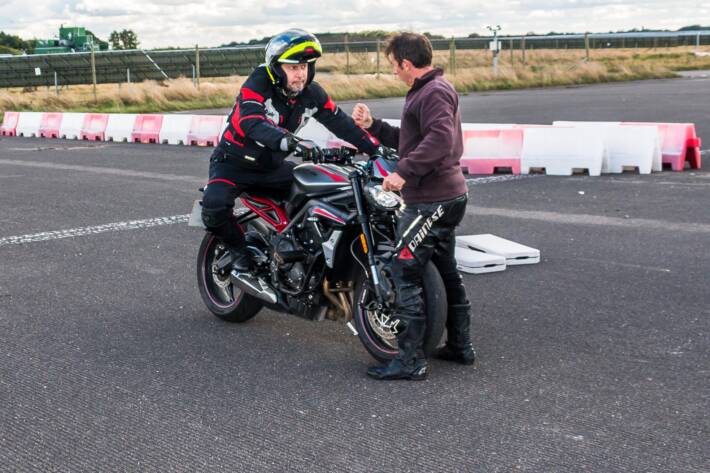
The acclaimed academy tours the UK, moving from track to track, and has a reputation for unpicking – and ‘repackaging’ – the way riders think and behave.
Using a unique mix of humour, psychology, demonstrations, track-side chats and a near mystical understanding of how motorcycles behave, it has transformed many pupils’ riding.
Tom’s method includes experimentation with ‘machine control’ – letting go of the handlebars and steering by using body weight alone, steering a bike while standing – hands-free – on the foot pegs. And by demonstrating physics with a bicycle wheel and an old tyre.
Surprise
So it comes as a surprise, when we meet on a deserted former RAF aerodrome in Norfolk, when Tom explains that getting your knee down doesn’t really transform your riding. Or your cornering. It’s not even necessary. And not everyone’s cut out for it.
What attempting the technique will do, however he says – as he spends a morning guiding us through carefully structured ‘building blocks’ towards getting our knees down, taking turns on his Triumph Speed Triple – is give us a far better understanding of what the bike is really capable of.
More importantly, it will give us a far better understanding of what happens to our bodies – and what goes through our minds – when we ride, regardless of whether we’re sitting upright, leaning, hanging off the bike, looking in the right (or wrong) direction, or just sitting on the machine with the engine off.
It will also – crucially – help us gauge just how far it is possible to lean a motorcycle, using knees – and our feet – as a fine-tuning ‘gauge’, informing us how close to the tarmac we’re really getting…
It’s strange motorcycle magic that – over the course of 4-5 hours – unpicks habits and cognitive biases built up during years of riding, replacing them with evidence-based science, experience and skills.
I’m in a group of three – together with a father/daughter combo who arrived on their own bikes. The first exercise is a simple 25mph figure of eight to acquaint us with the bike – and to prove that we can ride without falling off.
There’s plenty of room on the old runway, with the ever-present threat of grass verges and mesh fencing if we get it wrong.
Next, Tom asks us to discover what method of steering – leaning, or tweaking the handlebars – works best while repeating that figure of eight.
First, we use the handlebars then – in the ‘straight’ section – we’re encouraged to take our hands off the handlebars, steering by body weight alone, after nudging the bike into sixth gear and letting go of the throttle. “It won’t stall,” promises Tom. I don’t quite believe him but it turns out to be true…
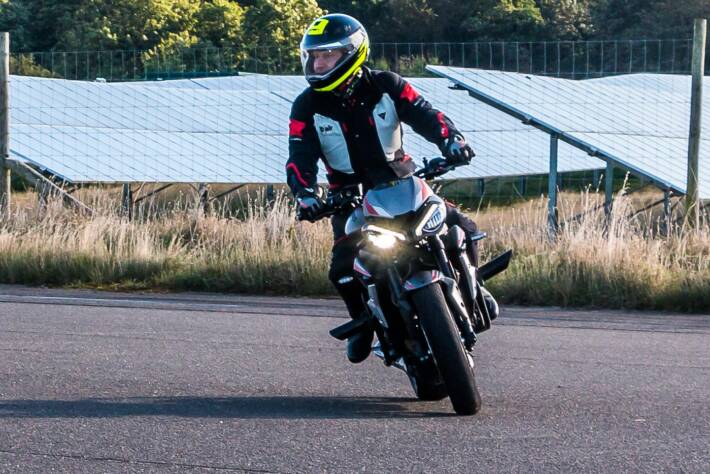
It’s easy on the straights but I find it impossible, at first, to lean in the bends without dabbing the handlebars. “It’s years of learned experience – your body influencing your mind,” reassures Tom. “It’ll come.”
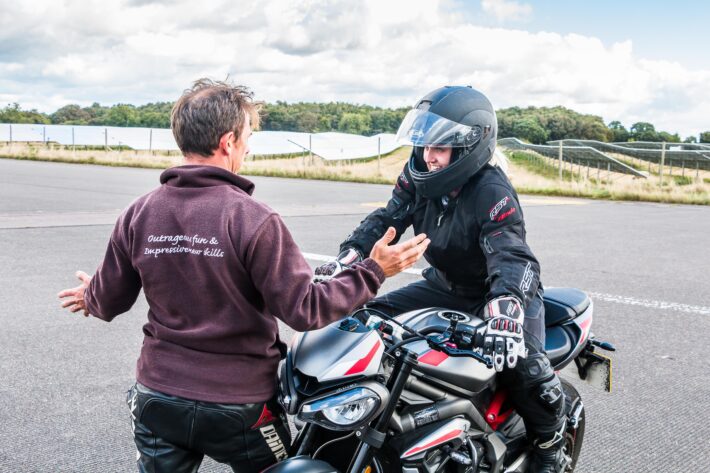
After repeated sessions – during which Peter (56) and Becky (28) Robertson, comfortably beat me to it – I can indeed negotiate that figure of eight without the ‘bars. But only while turning right – not left. No matter how hard I try.
MOTOGP
Next – interspersed by impressive, often fun, demos by Tom – we experiment by shifting our weight off the motorcycle in stages, between cones. As I do so, I have in mind the way that professional MOTO GP riders appear to ‘hang’ right off the bike.
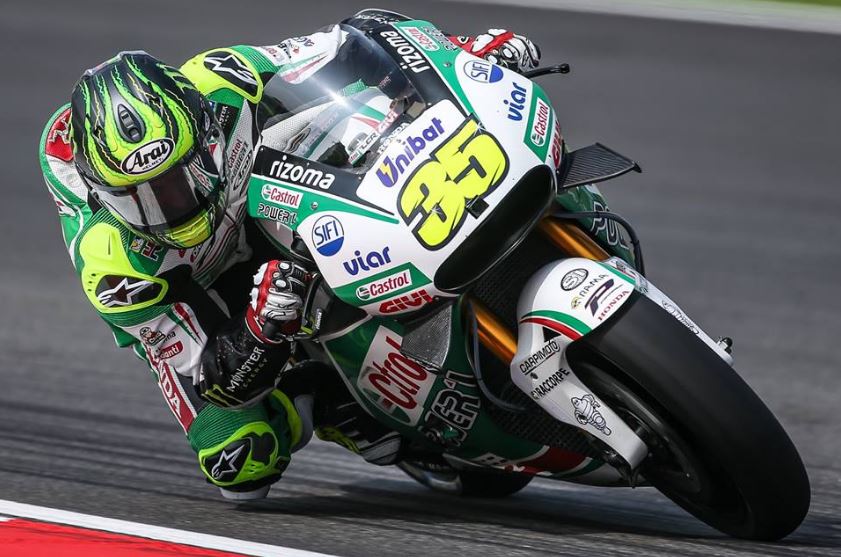
It’s harder than it looks, requiring concentration and some muscle power. But by moving the rider’s body ‘out’, it allows the bike to remain more upright so that strategic parts, such as the foot pegs, have more ground clearance. You don’t want them digging in and throwing you off, after all.
It feels disconcerting at first. But the further I inch off the saddle – remembering to lean not just my hips but my upper trunk – the far tighter my turns automatically become, even as the bike remains more upright.
The further my knee protrudes, the better the balance, the more sense I have of how close to the ground I can go. And, all the time, the tighter those circles become, all of their own accord.
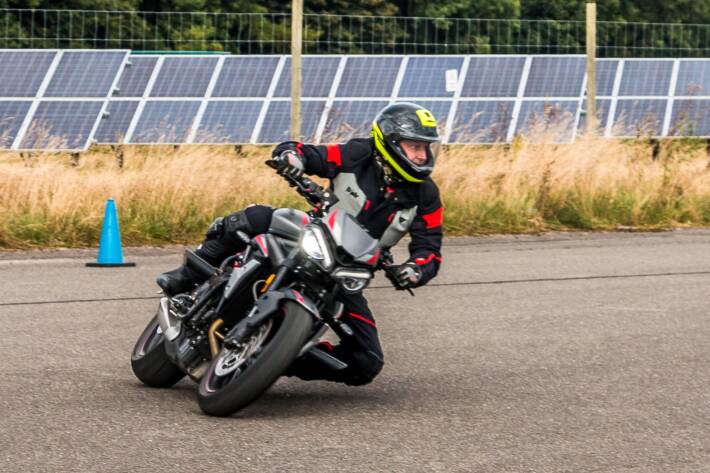
“Your body often reacts negatively towards sensations which in normal circumstances would require it to do something, for example correcting leaning while standing,” says Tom. “It’s why learning to lean with the bike can take a few cycles before it seems more possible.”
He’s right. The moment of truth arrives and Tom fits us with synthetic strap-on knee sliders and suggests we lean a little further while carefully edging our feet slightly beyond the end of the foot pegs, so that our boots can signal impending contact with the Tarmac.
Slowly, it all comes together. Inside knee akimbo, body – and now bike – leaning harder into the bend, speed rises, the bend tightens dramatically (useful if you’re in danger of running wide on road or circuit) and the corners feel a lot more stable.
Gauge
“It’s not actually necessary or important to get your knee down,” insists Tom. “But it lets you feel how far you really can lean the bike while it’s still under control. Think of it as a gauge as to how far the bike, and you, can lean if you want to.”
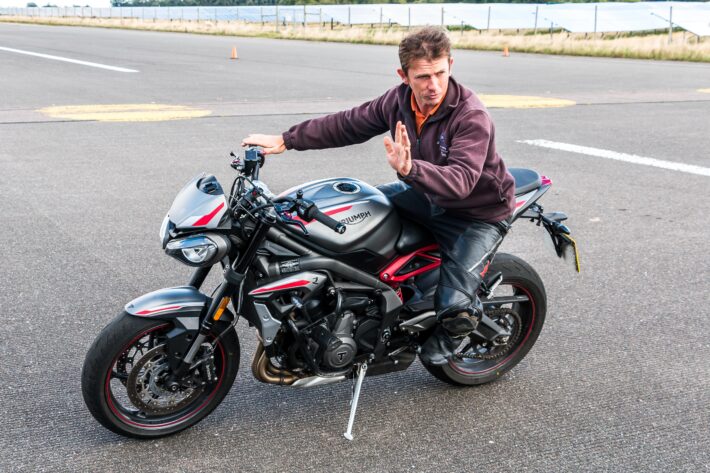
The tuition is also about accuracy, says Tom: ensuring you know precisely where you want the bike to be in the next corner, when you’re still lining it up for the one before, is crucial. And a vital skill on the road, too.
I feel like a pro as – repeatedly – I finally get my left knee to scrape the Tarmac, acclimatising to the sensation of leaning well off the bike. At least when I’m banking left.
Contrary to the earlier ‘hands-free’ experience when I could only steer to the right, I never do get my right knee to make that satisfying rasping sound against the wartime runway.
“Lean a little further,” advises Tom but my brain, or perhaps my body, or muscle memory, won’t have it. I’m still an inch from knee-down nirvana.
The feeling of euphoria is there however; it’s lots of fun while being given the licence – in comparative safety and under the eye of an expert – to play around with (someone else’s) bike. My cornering has improved dramatically, the bike feels more stable.
I have a better understanding of what’s going on in a bend. It just feels… right. And I’ve got an excuse to go back, to work on that other knee…
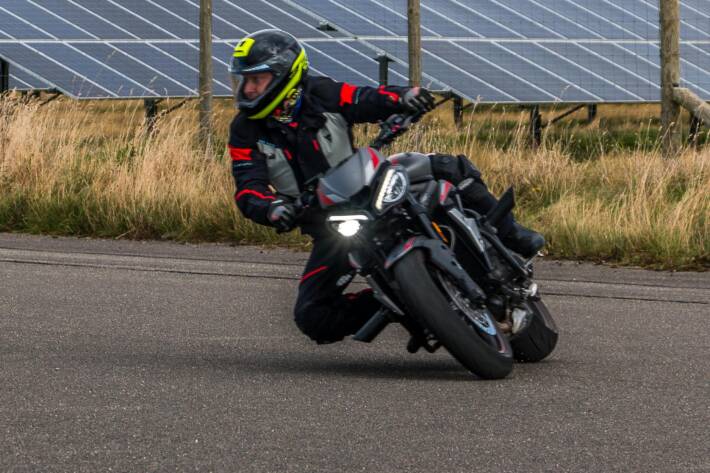
Will I do it on the road? I doubt it. It would mean I’m going too fast for comfort and I can’t think of a single bend – apart from roundabouts – where it would even be possible. Plus, hunkering down can hamper your vision – vital on the road.
Besides, my back, side and shoulder muscles ache for days afterwards… testament to the effort this technique actually requires when you’re not used to it.
On the upside, I have a far better understanding of my bike’s – and my own abilities. And I’ve gone some way to emulating those icons of the racing world. What’s not to like? Now I just need to crack that wheelie…..
Details: The Knee Down course costs £250.
And a word from the long arm of the law…
Inspector Colin Reid is Head of Road Policing and Driver Training, Police Scotland. He also advised on the new version of Motorcycle Roadcraft, the Police Rider’s Handbook.
“Living close to Knockhill, I have done a number of track-days and have used the knee down technique when doing so.
I have also experienced track instruction where knee down and leaning of the bike was encouraged.
I would never claim to be an expert at it but I understand the principles and the technique. However, it’s not something I would do on the public road and it’s not something we teach on police riding courses.
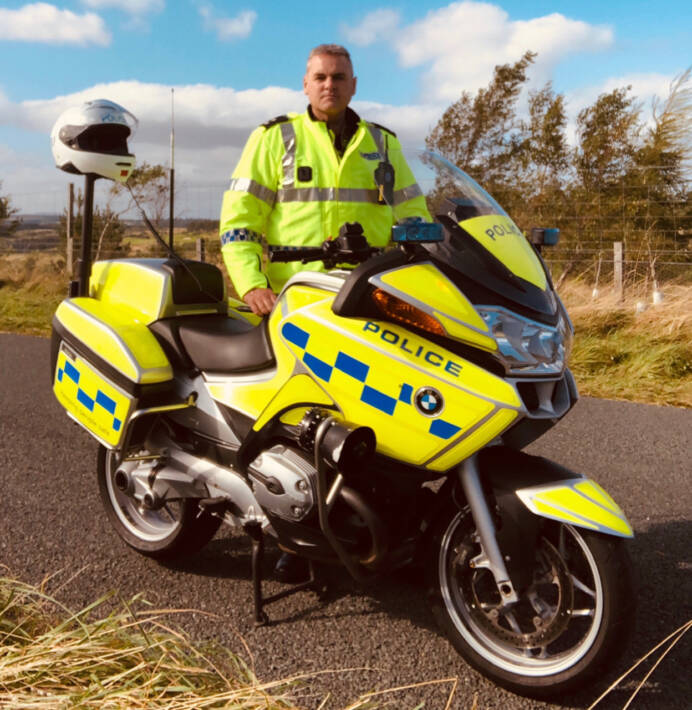
There are many arguments for the benefits/negatives of knee down and some bikers see it as a test of their ability!
However, the biker themself will run out of talent and ability long before the bike does – pushing the bike too far simply to get the knee down, which could result in too high a speed for the bend or being unprepared for unexpected hazards ahead.
Racetracks are also generally very smooth with no potholes or road debris – public roads are not like that. Potholes, a discarded juice bottle, tar banding on the bend – all causation factors I have established through crash investigation for crashes involving motorcycles.
Leaning the bike to the edge of the tyre has one major disadvantage – you have no tyre grip left or room for manoeuvre should anything go wrong. You should always have something left in reserve.
Safety must come first – a motorcyclist should position their machine in relation to the bend ahead, with careful regard for views, oncoming traffic, other hazards and ultimately their ability to negotiate the bend safely.
If they concentrate too much on getting the knee down, are they missing other factors which could prove disastrous?
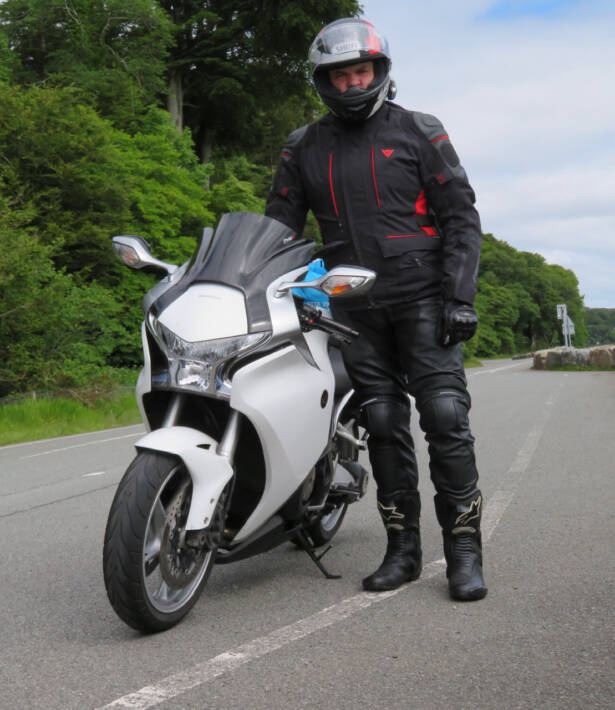
There is nothing which makes getting a knee down illegal. During police motorcycle instruction, we teach students to keep the machine as upright as possible and use counter-steer and slight changes in body position to negotiate bends safely.
This can include dropping an elbow, corresponding to the bend, to promote good counter-steering technique and moving your bottom across the seat to effectively lower the centre of gravity and keep the machine more upright.
For safe police riding at response speeds, this is sufficient – we do not instruct dropping the knee into the bend.
As an experienced motorcyclist I would recommend leaving knee down learning to the safe environment of track instruction and through one of the many companies who offer this level of understanding.
I would always suggest the motorcyclist puts safety first when riding on the roads and if they can incorporate knee down into this, safely and correctly to negotiate a bend, I can fully understand why they would do this.”
David Williams is a freelance journalist who specialises in road safety, transport and travel. He’s been the London Evening Standard’s motoring correspondent for 26 years, also contributing to the Daily and Sunday Telegraph, Sunday Times and various magazines. He is a Prince Michael of Kent International Road Safety Awards judge.
Twitter Handle – @djrwilliams

5 comments on “Knee-Down Nirvana, it is legal and what does it achieve?”
Excellent reading gives all different aspects and approach to bike riding. All makes sense especially with the way many use the roads today. I always try to apply the techniques mentioned when out on my vfr800 makes day out more enjoyable, plus your more aware of our road users.
Need to buy Road craft.
I agree entirely with Colin. Knee down and possibly touching the ground has no place on our roads today . With over 40.000.000 , that’s over forty million other vehicles on our roads its so dangerous not only to oneself but to all other road users.
What one must also understand is the limited braking that one has whilst on a bend. If one has a lean angle of say 40 deg. that’s about 40% of ones tyre grip and being used at a speed on a bend. That means that we have compromised braking capacity and the rule of safe stopping distance is then thrown out of the window. We may be able to see say 120 ft ahead which under normal circumstances, on a straight and dry road is the recommended stopping distance at that speed.
However leant over with a 40 deg. angle means that our ability to stop in an emergency no longer exists as we have a compromised braking ability. So much so that we now have only some 60% out of 100% of accessible grip left for braking in or altering our position.
So the distance that one can see to be clear, that 120ft is now of little value as if we have to brake for an emergency we cannot brake harder than 60% and if we are changing our path then that lowers that % even more otherwise we lose the remaining grip that our tyres have on the tarmac.
Not as dangerous on a race track where one can fall off and slide and not hit anything, not a hedge or kerb but on a country road with street furnishings and other vehicles heading towards us it could be deadly.
So remember next time you are on a bend that we must always be aware of what is or could be or might happen and ride accordingly and defensively,.. Knee downing is not defensive riding, its aggressive through and through and not really to be encouraged on our country roads. or any road for that matter. .
Too many riders get caught out on bends before we start with knee downing and they certainly making the most out of speed and add the new found capability in getting the knee down then its a recipe for disaster that could lose ones ones life or the life of an innocent party.
The Police are not much better as they are creating problems on overtakes and on bends. On both they recommend that at times its ok to Tailgate another vehicle especially one that one wants to overtake be it on a straight or on a bend. Overtaking it just after bend requires a motorcyclist to not only be closer to the target vehicle but to place ones self in such an insidious position for what affect to effect a known risky and sometimes dangerous manoeuvre .One should always ride to stop in “The distance seen to be clear and on ones own side of the road. Plus that one should never ever sacrifice one own and others safety for the sake of any other consideration.
So I think that the Police should look at their own training practises and procedures first..Especially those that they teach to civilians. I am not saying that its not necessary, certainly for a police officer, who needs to answer to an emergency call and to commit to an overtake from closer distances and where they have to weight up the pros and cons of whatever risk they may have to take and compare that with any increased risk to life and limb where they are required to be.
However we civilians don’t have to do that and assess whether someone will die or become more seriously injured if we don’t overtake in order to make faster progress.
Perhaps its time that again certain practises were left out of the next handbook for the safety of civilians.
One thing that has not been mentioned is the capability of the bike to lean. My scooter has a maximum lean angle of just 28 deg. . A custom bike, like a hog or Goldwing etc.. may have a maximum lean angle of maybe 30 to 40 deg. . A street and adventure bike could perhaps lean to 50 deg. A sports bike to maybe 55 to 60 deg.
I have seen many a video of bikers in the USA on canyon roads trying to push the envelope of speed and lean angle around left hand bends. [ They ride and drive on there left unlike us in the UK who drive on our right ] They watch a sports or street or adventure bike going round at high speed and with a lean angle of say 45/50 deg. They then try to emulate that speed and angle forgetting that on their bike, being a hog. they cannot lean anything like as much.
Plus in the USA a left hand bend has the camber higher to their left and to the middle of the road and the bike also has one or both of its bike stands on that same left hand side nearest that rising camber and so they sometimes bottom their stands on the road and that lifts the rear wheel of the bike up. Control is then lost and as a result they come off.
Just a quick correction to the above. We actually drive on the left and not as said on the right. In the USA they drive on their right and not as said on their left.